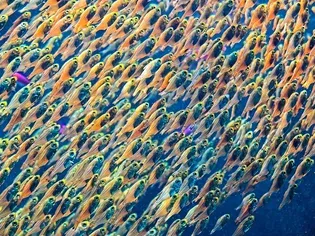Schooling Fish
Updated on 04/26/24

The Enthralling World of Schooling Fish: A Symphony of Synchronized Motion
Immerse yourself in the captivating realm of schooling fish, a spectacle that has captivated scientists, divers, and nature enthusiasts alike. These mesmerizing creatures have the remarkable ability to move in perfect unison, forming shimmering, swirling formations that dance through the ocean's depths. In this comprehensive guide, we delve into the fascinating world of schooling fish, exploring their behavior, benefits, and the remarkable adaptations that allow them to execute their extraordinary feats of synchronized movement.
Understanding Schooling Behavior
Schooling behavior, the coordinated movement of multiple individuals, is a common survival strategy among many species of fish. This synchronized swimming offers numerous advantages, including:
- Enhanced predator avoidance: By forming large, dense groups, schooling fish can create a "safety in numbers" effect. Predators find it more challenging to single out and capture an individual in such a cohesive group.
- Improved foraging efficiency: Schooling fish can locate and capture prey more effectively by working together. They can surround and trap prey, increasing their chances of a successful catch.
- Energy conservation: Swimming in a school reduces the energetic cost of locomotion for individual fish. By aligning their movements with the group, they minimize drag and optimize their use of energy.
Adaptations for Synchronized Movement
To achieve their remarkable synchronized movements, schooling fish rely on a combination of sophisticated adaptations:
- Sensory Integration: Schooling fish have highly developed sensory systems, particularly their lateral lines and vision, which allow them to detect nearby individuals and their movements.
- Social Communication: They also possess specialized social communication abilities, using subtle body language, visual cues, and chemical signals to coordinate their actions.
- Leadership Hierarchies: Within some schooling species, there is a clear leadership hierarchy, with dominant individuals influencing the direction and formation of the group.
Examples of Schooling Behavior in Different Species
The diversity of schooling behavior among fish species is remarkable, with different groups exhibiting unique patterns and formations:
- Sardine Runs: Sardines, renowned for their massive schooling behavior, form vast, silvery clouds that can stretch for kilometers. These schools often contain millions of individuals, creating spectacular displays of shimmering movement.
- Tuna Schools: Tuna, particularly yellowfin and skipjack species, form schools that can range in size from a few individuals to thousands. They swim in tight, hydrodynamic formations, optimizing their ability to pursue prey.
- schooling jacks: Jacks, such as the blue jack and the yellow jack, are known for their rapid, agile schooling behavior. Their schools move in synchronized bursts, dodging predators and chasing down prey.
- Bait Balls: Bait balls are temporary aggregations of small fish, often occurring when threatened by predators. These balls can contain individuals from different species, forming dense, swirling masses that confuse predators and provide protection.
Benefits of Schooling Fish for Ocean Ecosystems
Schooling fish play a vital role in maintaining the balance and health of marine ecosystems:
- Food Sources: Schooling fish are a primary food source for larger predators, including sharks, tuna, and marine mammals. Their abundance supports the intricate food webs of the ocean.
- Nutrient Cycling: The waste products from schooling fish contribute to the cycling of nutrients, benefiting other marine organisms and enriching the overall ecosystem.
- Habitat Creation: Schooling fish often associate with specific underwater structures, such as coral reefs or seamounts, providing shelter and food for other species.
Conclusion
The world of schooling fish is a testament to the wonders and complexities of nature. Their ability to execute synchronized movements is a captivating sight, and their presence in marine ecosystems is crucial for the health and balance of our oceans. By understanding their behavior and adaptations, we gain a deeper appreciation for the beauty and wisdom that nature holds. Whether you're a seasoned diver, a marine enthusiast, or simply curious about the wonders of the sea, the enigmatic world of schooling fish will continue to enchant and inspire for generations to come.
Explore More Pets

Freshwater Aquarium Filters
How to Deal With Cloudy Aquarium Water

Saltwater Aquarium Filters
How Do You Remove Chloramines From Tap Water?

Freshwater Aquariums & Habitat
Can I Keep My Koi Fish Inside?

Saltwater Aquariums & Habitat
14 Best Floating Plants for Your Aquarium

Freshwater Fish Health
How to Treat Ich on Freshwater Fish

Saltwater Fish Health
Fin Rot in Aquarium Fish

Freshwater Aquarium Filters
How to Do Aquarium Water Changes

Saltwater Fish Health
How Do Fish Get Parasites?